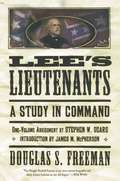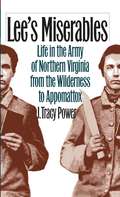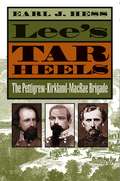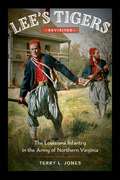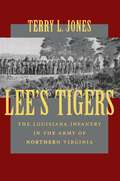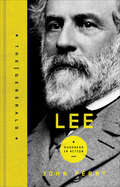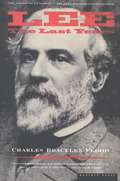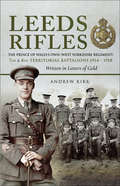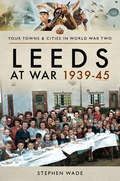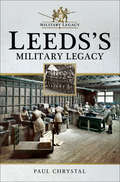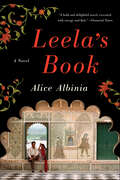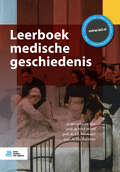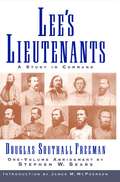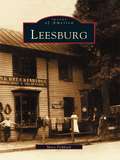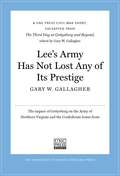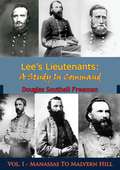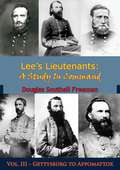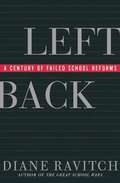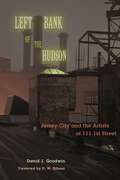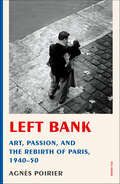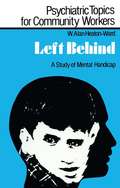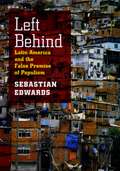- Table View
- List View
Lee's Lieutenants Third Volume Abridged: A Study in Command
by Douglas Southall FreemanLee's Lieutenants: A Study in Command is the most colorful and popular of Douglas Southall Freeman's works. A sweeping narrative that presents a multiple biography against the flame-shot background of the American Civil War, it is the story of the great figures of the Army of Northern Virginia who fought under Robert E. Lee.The Confederacy won resounding victories throughout the war, but seldom easily or without tremendous casualties. Death was always on the heels of fame, but the men who commanded -- among them Jackson, Longstreet, and Ewell -- developed as leaders and men. Lee's Lieutenants follows these men to the costly battle at Gettysburg, through the deepening twilight of the South's declining military might, and finally to the collapse of Lee's command and his formal surrender in 1865. To his unparalleled descriptions of men and operations, Dr. Freeman adds an insightful analysis of the lessons learned and their bearing upon the future military development of the nation. Accessible at last in a one-volume edition abridged by noted Civil War historian Stephen W. Sears, Lee's Lieutenants is essential reading for all Civil War buffs, students of war, and admirers of the historian's art as practiced at its very highest level.
Lee's Lieutenants: A Study in Command (Lee's Lieutenants: A Study In Command Ser. #3)
by Douglas Southall FreemanLee's Lieutenants: A Study in Command is the most colorful and popular of Douglas Southall Freeman's works. A sweeping narrative that presents a multiple biography against the flame-shot background of the American Civil War, it is the story of the great figures of the Army of Northern Virginia who fought under Robert E. Lee.The Confederacy won resounding victories throughout the war, but seldom easily or without tremendous casualties. Death was always on the heels of fame, but the men who commanded—among them Jackson, Longstreet, and Ewell—developed as leaders and men. Lee's Lieutenants follows these men to the costly battle at Gettysburg, through the deepening twilight of the South's declining military might, and finally to the collapse of Lee's command and his formal surrender in 1865. To his unparalleled descriptions of men and operations, Dr. Freeman adds an insightful analysis of the lessons learned and their bearing upon the future military development of the nation. Accessible at last in a one-volume edition abridged by noted Civil War historian Stephen W. Sears, Lee's Lieutenants is essential reading for all Civil War buffs, students of war, and admirers of the historian's art as practiced at its very highest level.
Lee's Miserables
by J. Tracy PowerNever did so large a proportion of the American population leave home for an extended period and produce such a detailed record of its experiences in the form of correspondence, diaries, and other papers as during the Civil War. Based on research in more than 1,200 wartime letters and diaries by more than 400 Confederate officers and enlisted men, this book offers a compelling social history of Robert E. Lee's Army of Northern Virginia during its final year, from May 1864 to April 1865. Organized in a chronological framework, the book uses the words of the soldiers themselves to provide a view of the army's experiences in camp, on the march, in combat, and under siege--from the battles in the Wilderness to the final retreat to Appomattox. It sheds new light on such questions as the state of morale in the army, the causes of desertion, ties between the army and the home front, the debate over arming black men in the Confederacy, and the causes of Confederate defeat. Remarkablyrich and detailed, Lee's Miserables offers a fresh look at one of the most-studied Civil War armies. "A landmark book. . . . When the end came, the men of the Army of Northern Virginia passed into legend. Power's important study brings a large measure of reality back to their story.--Edward D. C. Campbell, Jr., American History"Power's research is voluminous and his conclusions sensible and thought-provoking. The result is a major and welcome addition to the literature of how armies are made and how they die.--Steven E. Woodworth, Blue & Gray Education Society Newsletter"A classic Civil War study--immensely useful to the historian, vigorous and enlightening to the common reader. It is a glimpse into the American soul: what is best and worst about us, our riches and griefs, discontents, yearnings, murderous urges, and abiding faith.--Donald McCaig, Washington Post Book World"One of the finest works ever written on the Army of Northern Virginia.--Keith Bohannon, Civil War HistoryBased on research in more than 1,200 wartime letters and diaries by more than 400 Confederate officers and enlisted men, Lee's Miserables offers a compelling social history of Robert E. Lee's Army of Northern Virginia during its final year, from May 1864 to April 1865. The book uses the words of the soldiers themselves to provide a richly detailed view of the army's experiences in camp, on the march, in combat, and under siege--from the battles in the Wilderness to the final retreat to Appomattox. -->
Lee's Tar Heels
by Earl J. HessThe Pettigrew-Kirkland-MacRae Brigade was one of North Carolina's best-known and most successful units during the Civil War. Formed in 1862, the brigade spent nearly a year protecting supply lines before being thrust into its first major combat at Gettysburg. There, James Johnston Pettigrew's men pushed back the Union's famed Iron Brigade in vicious fighting on July 1 and played a key role in Pickett's Charge on July 3, in the process earning a reputation as one of the hardest-fighting units in Robert E. Lee's Army of Northern Virginia. Despite suffering heavy losses during the Gettysburg campaign, the brigade went on to prove its valor in a host of other engagements. It marched with Lee to Appomattox and was among the last Confederate units to lay down arms in the surrender ceremony.Earl Hess tells the story of the men of the Pettigrew-Kirkland-MacRae Brigade, and especially the famous 26th North Carolina, chronicling the brigade's formation and growth under Pettigrew and its subsequent exploits under William W. Kirkland and William MacRae. Beyond recounting the brigade's military engagements, Hess draws on letters, diaries, memoirs, and service records to explore the camp life, medical care, social backgrounds, and political attitudes of these gallant Tar Heels. He also addresses the continuing debate between North Carolinians and Virginians over the failure of Pickett's Charge.
Lee's Tigers Revisited: The Louisiana Infantry in the Army of Northern Virginia
by Terry L. JonesIn Lee’s Tigers Revisited, noted Civil War scholar Terry L. Jones dramatically expands and revises his acclaimed history of the approximately twelve thousand Louisiana infantrymen who fought in Robert E. Lee’s Army of Northern Virginia. Sometimes derided as the “wharf rats from New Orleans” and the “lowest scrappings of the Mississippi,” the Louisiana Tigers earned a reputation for being drunken and riotous in camp, but courageous and dependable on the battlefield. Louisiana’s soldiers, some of whom wore colorful uniforms in the style of French Zouaves, reflected the state’s multicultural society, with regiments consisting of French-speaking Creoles and European immigrants. Units made pivotal contributions to many crucial battles—resisting the initial Union onslaught at First Manassas, facilitating Stonewall Jackson’s famous Valley Campaign, holding the line at Second Manassas by throwing rocks when they ran out of ammunition, breaking the Union line temporarily at Gettysburg’s Cemetery Hill, containing the Union breakthrough at Spotsylvania’s Bloody Angle, and leading Lee’s attempted breakout of Petersburg at Fort Stedman. The Tigers achieved equal notoriety for their outrageous behavior off the battlefield, so much so that sources suggest no general wanted them in his command. By the time of Lee’s surrender at Appomattox, there were fewer than four hundred Louisiana Tigers still among his troops. Lee’s Tigers Revisited uses letters, diaries, memoirs, newspaper articles, and muster rolls to provide a detailed account of the origins, enrollments, casualties, and desertion rates of these soldiers. Illustrations—including several maps newly commissioned for this edition—chart the Tigers’ positions on key battlefields in the tumultuous campaigns throughout Virginia. By utilizing first-person accounts and official records, Jones provides the definitive study of the Louisiana Tigers and their harrowing experiences in the Civil War.
Lee's Tigers: The Louisiana Infantry in the Army of Northern Virginia
by Terry L. JonesSometimes called the "wharf rats from New Orleans" and the "lowest scrapings of the Mississippi," Lee's Tigers were the approximately twelve thousand Louisiana infantrymen who served in the Confederate Army of Northern Virginia from the time of the campaign at First Manassas to the final days of the war at Appomattox. Terry L. Jones offers a colorful, highly readable account of this notorious group of soldiers renowned not only for their drunkenness and disorderly behavior in camp but for their bravery in battle. It was this infantry that held back the initial Federal onslaught at First Manassas, made possible General Stonewall Jackson's famed Valley Campaign, contained the Union breakthrough at Spotsylvania's Bloody Angle, and led Lee's last offensive actions at Fort Stedman and Appomattox.Despite all their vices, Lee's Tigers emerged from the Civil War with one of the most respected military records of any group of southern soldiers. According to Jones, the unsavory reputation of the Tigers was well earned, for Louisiana probably had a higher percentage of criminals, drunkards, and deserters in its commands than any other Confederate state. The author spices his narrative with well-chosen anecdotes-among them an account of one of the stormiest train rides in military history. While on their way to Virginia, the enlisted men of Coppens' Battalion uncoupled their officers' car from the rest of the train and proceeded to partake of their favorite beverages. Upon arriving in Montgomery, the battalion embarked upon a drunken spree of harassment, vandalism, and robbery. Meanwhile, having commandeered another locomotive, the officers arrived and sprang from their train with drawn revolvers to put a stop to the disorder. "The charge of the Light Brigade," one witness recalled, "was surpassed by these irate Creoles."Lee's Tigers is the first study to utilize letters, diaries, and muster rolls to provide a detailed account of the origins, enrollments, casualties, and desertion rates of these soldiers. Jones supplies the first major work to focus solely on Louisiana's infantry in Lee's army throughout the course of the war. Civil War buffs and scholars alike will find Lee's Tigers a valuable addition to their libraries.
Lee: Goodness in Action (The Generals Series)
by John PerryA biography of the often misunderstood, yet heroic, Confederate general who sacrificed everything for his native state of Virginia during the Civil War. Traitor. Divider. Defender of slavery. This damning portrayal of Robert E. Lee has persisted through 150 years of history books. And yet it has no basis in fact.In the spirit of bold restoration, Lee: A Life of Virtue reveals the true Lee—passionate patriot, caring son, devoted husband, doting father, don’t-tread-on-me Virginian, Godfearing Christian.Weaving forgotten facts and revelations (Lee considered slavery a moral outrage) with striking personal details (for years he carried his weakened mother to and from her carriage), biographer John Perry crafts a compelling treatment of the virtuous warrior who endured withering opposition and sacrificed all to stand for Constitutional freedoms.
Lee: The Last Years
by Charles Bracelen FloodA New York Times bestselling author&’s revealing account of General Robert E. Lee&’s life after Appomattox: &“An American classic" (Atlanta Journal-Constitution). After his surrender at Appomattox in 1865, Robert E. Lee, commanding general for the Confederate Army of Northern Virginia during the Civil War, lived only five more years. It was the great forgotten chapter of his remarkable life, during which Lee did more to bridge the divide between the North and the South than any other American. The South may have lost, but Lee taught them how to triumph in peace, and showed the entire country how to heal the wounds of war. Based on previously unseen documents, letters, family papers and exhaustive research into Lee&’s complex private life and public crusades, this is a portrait of a true icon of Reconstruction and quiet rebellion. From Lee&’s urging of Rebel soldiers to restore their citizenship, to his taking communion with a freedman, to his bold dance with a Yankee belle at a Southern ball, to his outspoken regret of his soldierly past, to withstanding charges of treason, Lee embodied his adage: &“True patriotism sometimes requires of men to act exactly contrary, at one period, to that which it does at another.&” Lee: The Last Years sheds a vital new light on war, politics, hero-worship, human rights, and Robert E. Lee&’s &“desire to do right.&”
Leeches, Maggots, and Skulls: Curious Cures from History (Fountas & Pinnell Classroom, Guided Reading)
by Dave Smith Lynda JonesNIMAC-sourced textbook. EW! Imagine eating bedbugs to cure a cold. Or swallowing leeches to heal your swollen tonsils. History is full of odd cures like these. Travel back in time to learn about the sometimes-horrid history of healing.
Leeds Rifles: The Prince of Wales's Own (West Yorkshire Regiment) 7th and 8th Territorial Battalions 1914–1918: Written in Letters of Gold
by Andrew J. KirkThe first detailed chronicle, with photos included, of the four battalions of riflemen who left Leeds for the Western Front. The full wartime story of the &“Leeds Pals&” has never been told. This volume describes their volunteer origins and how they came to be woven into the social fabric of Leeds from where they drew their enduring esprit de corps, discipline, and resolve. It takes the reader on a journey across the Western Front of the Great War, contrasting the first line battalion&’s lot, to stand in the mud of Ypres and endure all without breaking, with the second line battalion&’s blooding at Bullecourt and transformation as part of an elite assault division that went on to occupy Germany. It is told, in part, by those who were there and experienced the fear, elation, and sadness of loss, and who took strength from their volunteer ethos and their common origins in Leeds. All the Leeds Rifles&’ main battles are described in detail as are the helter-skelter actions of the last one hundred days of mobile warfare and escalating casualties, when the defeated but still defiant German army found itself in full and final retreat. Follow the fortunes of these enfants de Yorkshire, these Leeds Lads, as they speak out from the pages of history with a very familiar accent.
Leeds at War, 1939–45 (Your Towns & Cities in World War Two)
by Stephen WadeLeeds at War 1939-1945 is a comprehensive account of the city's experience of the war, covering in expert detail life on the Home Front set against the background of the wider theaters of war.The narrative of that global conflict is given with a focus on the trials and ordeals that faced the people of Leeds as they cheered their men and women fighters off to war, were bombed and saw their children evacuated to rural areas.Rare insights into the life of war-torn Leeds are included, along with untold stories from the footnotes of that history, from the air-raid shelters to the internment issues. The book incorporates the unique human record of that struggle from memoirs and memories, so that the reader sees the war bottom up from the ordinary people, although the military experiences of Leeds' citizens are not ignored.More controversial topics are also touched upon, such as anti-Semitism, labor troubles and crime, to give a full and fascinating picture of a great city facing profound trials of endurance, courage, and that true Yorkshire grit that has been the hallmark of the city's rise to prominence in Britain.
Leeds's Military Legacy (Military Legacy)
by Paul ChrystalLeedss Military Legacy is the first fully illustrated book to give a comprehensive description of the military history of Leeds from Roman, Anglo-Saxon and Norman times to the present as home to various garrisons and military museums, not least the renowned Leeds Armouries Museum. Along the way it describes Royalist Leeds and the Civil War, the formation of various regiments in the city between the seventeenth and twenty-first centuries, the impact of two World Wars and how the city rose to the challenges of recruitment, defense and industrial war effort. The battle honors of each of the Leeds regiments are detailed as are the VCs. The book also covers the work of the Leeds military hospitals, the Barnbow Munitions disaster, RAF Yeadon (LeedsBradford Airport), the blitz of 1941, 609 Squadron, Yeadon Lancaster factory, Leeds as a garrison city and current military research in Leeds.
Leela's Book: A Novel
by Alice Albinia"Steeped in the tradition of the Indian epic, yet modern and vastly entertaining." —The Times (London)In her fiction debut, Alice Albinia weaves a multithreaded epic tale that encompasses divine saga and familial discord and introduces an unforgettable heroine. Leela—alluring, taciturn, haunted—is moving from New York back to Delhi. Worldly and accomplished, she has been in self-imposed exile from India and her family for decades; twenty-two years earlier, her sister was seduced by the egotistical Vyasa, and the fallout from their relationship drove Leela away. Now an eminent Sanskrit scholar, Vyasa is preparing for his son’s marriage. But when Leela arrives for the wedding, she disrupts the careful choreography of the weekend, with its myriad attendees and their conflicting desires.Gleefully presiding over the drama is Ganesh—divine, elephant-headed scribe of the Mahabharata, India’s great epic. The family may think they have arranged the wedding for their own selfish ends, but according to Ganesh it is he who is directing events—in a bid to save Leela, his beloved heroine, from Vyasa. As the weekend progresses, secret online personas, maternal identities, and poetic authorships are all revealed; boundaries both religious and continental are crossed; and families are ripped apart and brought back together in this vibrant and brilliant celebration of family, love, and storytelling.
Leerboek medische geschiedenis
by H.F.P. Hillen E. S. Houwaart F. G. HuismanHoe is in de loop van de tijd gereageerd op bedreigingen van de volksgezondheid? Waar, hoe en door wie werd de daartoe benodigde kennis verworven? Hoe werd die kennis in de praktijk gebracht? Bij wie ligt eigenlijk de verantwoordelijkheid voor de gezondheidszorg? Wat kunnen we leren van het verleden? Het Leerboek medische geschiedenis biedt studenten geneeskunde en gezondheidswetenschappen een overzicht van zowel de wetenschappelijke als de maatschappelijke ontwikkelingen van de geneeskunde en de doorwerking daarvan in de moderne gezondheidszorg. Daarbij is niet alleen aandacht voor de vooruitgang in de geneeskunde, maar ook voor de paradoxen in het stelsel. Steeds vaker dwingen wetenschappelijke doorbraken de geneeskunde na te denken over haar opdracht, grenzen en beperkingen.De thematische opbouw van het leerboek past bij de moderne visie op de medische geschiedenis. In vier delen (‘Ziekte’, ‘Kennis’, ‘Dokter en patiënt’ en ‘Maatschappij en gezondheidszorg’) biedt het een kader voor reflectie op de huidige medische praktijk. Per hoofdstuk zijn competenties, leerdoelen en leervragen geformuleerd. Het boek sluit daarmee naadloos aan bij het competentiegerichte onderwijs en het Raamplan Artsopleiding. De redactie heeft nationale en internationale auteurs geselecteerd die als onderzoeker en docent van de betreffende thema’s hun sporen hebben verdiend.
Lees Lieutenants 3 Volume Abridged
by Stephen W. Sears Douglas Southall FreemanA towering landmark in Civil War literature, long considered one of the great masterpieces of military history -- now available in a one-volume abridgment. Lee's Lieutenants: A Study in Command is the most colorful and popular of Douglas Southall Freeman's works. A sweeping narrative that presents a multiple biography against the flame-shot background of the American Civil War, it is the story of the great figures of the Army of Northern Virginia who fought under Robert E. Lee. Dr. Freeman describes the early rise and fall of General Beauregard, the developing friction between Jefferson Davis and Joseph E. Johnston, the emergence and failure of a number of military charlatans, and the triumphs of unlikely men at crucial times. He also describes the rise of the legendary "Stonewall" Jackson and traces his progress in the Shenandoah Valley Campaign and into Richmond amid the acclaim of the South. The Confederacy won resounding victories throughout the war, but seldom easily or without tremendous casualties. Death was always on the heels of fame, but the men who survived -- among them Jackson, Longstreet, and Ewell -- developed as commanders and men. Lee's Lieutenants follows these men to the costly battle at Gettysburg, through the deepening twilight of the South's declining military might, and finally to the collapse of Lee's command and his formal surrender in 1865. To his unparalleled descriptions of men and operations, Dr. Freeman adds an insightful analysis of the lessons learned and their bearing upon the future military development of the nation. Accessible at last in a one-volume edition abridged by noted Civil War historian Stephen W. Sears, Lee's Lieutenants is essential reading for all Civil War buffs, students of war, and admirers of the historian's art as practiced at its very highest level.
Leesburg (Images of America)
by Mary FishbackOnce serving as the capital of the United States for three days, the town of Leesburg, Virginia stands at the crossroads of American history. As a rural hinterland of the Washington, D.C. area and situated on the northern fringe of the old Confederacy, Leesburg has seen troops and generals, travelers and settlers, and politicians and presidents walk its streets, and opposing political views tear its population apart. Unity and patriotism returned and characterized the town during the world wars. With the arrival of nearby Dulles International Airport in the 1960s, Leesburg and its surrounding towns experienced a different kind of movement-tremendous population growth.Today, Leesburg is a vital and fast-paced part of Northern Virginia's economy. Yet, despite its modern edge, the town has maintained its old rural character and has striven to preserve its colorful 245-year-old history.
Lee’s Army Has Not Lost Any of Its Prestige
by Gary W. GallagherIn this Civil War Short, Gary W. Gallagher surveys Confederate sentiment in the summer of 1863 and argues that many southerners did not view the battle of Gettysburg as a resounding defeat. Gallagher makes the compelling case that, although southern casualties were tremendous, Confederates across the South, along with the vast majority of Lee's soldiers, persisted in viewing Robert E. Lee as an invincible commander whose army increasingly sustained the hopes of the nation. The work was originally published in The Third Day at Gettysburg and Beyond, edited by Gary W. Gallagher, which combines fresh evidence with the reinterpretation of standard sources to testify to the enduring impact of the Civil War on our national consciousness and refocus our view of the third day at Gettysburg. UNC Press Civil War Shorts excerpt rousing narratives from distinguished books published by the University of North Carolina Press on the military, political, social, and cultural history of the Civil War era. Produced exclusively in ebook format, they focus on pivotal moments and figures and are intended to provide a concise introduction, stir the imagination, and encourage further exploration of the topic. For in-depth analysis, contextualization, and perspective, we invite readers to consider the original publications from which these works are drawn.
Lee’s Lieutenants: Vol. I - Manassas To Malvern Hill (Lee’s Lieutenants: A Study In Command #1)
by Douglas Southall FreemanFollowing the critical success of R. E. Lee: A Biography, for which he won the 1935 Pulitzer Prize, author Douglas Southall Freeman expanded his study of the Confederacy with the critically acclaimed three-volume Lee's Lieutenants: A Study in Command, originally published in 1942, 1943, and 1944.Together, the three volumes present a unique combination of military strategy, biography, and Civil War history, and shows how armies actually work. Published during World War II, it had a great influence on American military leaders and strategists.Lee's Lieutenants: A Study in Command established Freeman as the pre-eminent military historian in the country, and led to close friendships with United States generals George Marshall and Dwight D. Eisenhower.
Lee’s Lieutenants: Vol. II - Cedar Mountain to Chancellorsville (Lee’s Lieutenants: A Study In Command #2)
by Douglas Southall FreemanFollowing the critical success of R. E. Lee: A Biography, for which he won the 1935 Pulitzer Prize, author Douglas Southall Freeman expanded his study of the Confederacy with the critically acclaimed three-volume Lee's Lieutenants: A Study in Command, originally published in 1942, 1943, and 1944.Together, the three volumes present a unique combination of military strategy, biography, and Civil War history, and shows how armies actually work. Published during World War II, it had a great influence on American military leaders and strategists.Lee's Lieutenants: A Study in Command established Freeman as the pre-eminent military historian in the country, and led to close friendships with United States generals George Marshall and Dwight D. Eisenhower.
Lee’s Lieutenants: Vol. III - Gettysburg to Appomattox (Lee’s Lieutenants: A Study In Command #3)
by Douglas Southall FreemanFollowing the critical success of R. E. Lee: A Biography, for which he won the 1935 Pulitzer Prize, author Douglas Southall Freeman expanded his study of the Confederacy with the critically acclaimed three-volume Lee's Lieutenants: A Study in Command, originally published in 1942, 1943, and 1944.Together, the three volumes present a unique combination of military strategy, biography, and Civil War history, and shows how armies actually work. Published during World War II, it had a great influence on American military leaders and strategists.Lee's Lieutenants: A Study in Command established Freeman as the pre-eminent military historian in the country, and led to close friendships with United States generals George Marshall and Dwight D. Eisenhower.
Left Back: A Century of Failed School Reforms
by Diane RavitchFor the past one hundred years, Americans have argued and worried about the quality of their schools. Some have charged that students were not learning enough, while others have complained that the schools were not in the forefront of social progress. In this authoritative history of education in the twentieth century, historian Diane Ravitch describes this ongoing battle of ideas and explains why school reform has so often failed. "Left Back" recounts grandiose efforts by education reformers to use the schools to promote social and political goals, even when they diminished the schools' ability to educate children. It shows how generations of reformers have engaged in social engineering, advocating such innovations as industrial education, intelligence testing, curricular differentiation, and life-adjustment education. These reformers, she demonstrates, simultaneously mounted vigorous campaigns against academic studies. "Left Back" charges that American schools have been damaged by three misconceptions. The first is the belief that the schools can solve any social or political problem. The second is the belief that only a po
Left Bank of the Hudson: Jersey City and the Artists of 111 1st Street
by David J. GoodwinIn the late 1980s, a handful of artists priced out of Manhattan and desperately needing affordable studio space discovered 111 1st Street, a former P. Lorillard Tobacco Company warehouse. Over the next two decades, an eclectic collection of painters, sculptors, musicians, photographers, filmmakers, and writers dreamt and toiled within the building’s labyrinthine halls. The local arts scene flourished, igniting hope that Jersey City would emerge as the next grassroots center of the art world. However, a rising real estate market coupled with a provincial political establishment threatened the community at 111 1st Street. The artists found themselves entangled in a long, complicated, and vicious fight for their place in the building and for the physical survival of 111 1st Street itself, a site that held so much potential, so much promise for Jersey City.Left Bank of the Hudson offers a window into the demographic, political, and socio-economic changes experienced by Jersey City during the last thirty years. Documenting the narrative of 111 1st Street as an act of cultural preservation, author David J. Goodwin’s well-researched and significant contribution addresses the question of the role of artists in economically improving cities. As a Jersey City resident, Goodwin applies his knowledge of the city’s rich history of political malfeasance and corruption, including how auspicious plans for a waterfront arts enclave were repeatedly bungled by a provincial-minded city administration. In writing this story, Goodwin interviewed thirteen artists and residents, two businesses, three government officials, and five non-profits, civic organizations, and community activists. The book chronologically explores the history and business of the P. Lorillard Tobacco Company, its evolution into a bustling arts community, the battle to preserve the warehouse as a historic structure, and the lessons to be drawn from the loss and ultimate demolition of the building in 2007, as well as the present state of the neighborhood. Setting the facts straight for future generations, Left Bank of the Hudson provides an illustrative lesson to government officials, scholars, students, activists, and everyday citizens attempting to navigate the “rediscovery” of American cities.
Left Bank: Art, Passion, and the Rebirth of Paris, 1940–50
by Agnès PoirierAn incandescent group portrait of the midcentury artists and thinkers whose lives, loves, collaborations, and passions were forged against the wartime destruction and postwar rebirth of ParisIn this fascinating tour of a celebrated city during one of its most trying, significant, and ultimately triumphant eras, Agnes Poirier unspools the stories of the poets, writers, painters, and philosophers whose lives collided to extraordinary effect between 1940 and 1950. She gives us the human drama behind some of the most celebrated works of the 20th century, from Richard Wright’s Native Son, Simone de Beauvoir's The Second Sex, and James Baldwin's Giovanni's Room to Samuel Beckett's Waiting for Godot and Saul Bellow's Augie March, along with the origin stories of now legendary movements, from Existentialism to the Theatre of the Absurd, New Journalism, bebop, and French feminism.We follow Arthur Koestler and Norman Mailer as young men, peek inside Picasso’s studio, and trail the twists of Camus's Sartre's, and Beauvoir’s epic love stories. We witness the births and deaths of newspapers and literary journals and peer through keyholes to see the first kisses and last nights of many ill-advised bedfellows. At every turn, Poirier deftly hones in on the most compelling and colorful history, without undermining the crucial significance of the era. She brings to life the flawed, visionary Parisians who fell in love and out of it, who infuriated and inspired one another, all while reconfiguring the world's political, intellectual, and creative landscapes. With its balance of clear-eyed historical narrative and irresistible anecdotal charm, Left Bank transports readers to a Paris teeming with passion, drama, and life.
Left Behind: A Study of Mental Handicap
by W. Alan Heaton-WardFirst Published in 1978. Routledge is an imprint of Taylor & Francis, an informa company.
Left Behind: Latin America and the False Promise of Populism
by Sebastian EdwardsThe political and economic history of Latin America has been marked by great hopes and even greater disappointments. Despite abundant resources--and a history of productivity and wealth--in recent decades the region has fallen further and further behind developed nations, surpassed even by other developing economies in Southeast Asia and elsewhere. In Left Behind, Sebastian Edwards explains why the nations of Latin America have failed to share in the fruits of globalization and forcefully highlights the dangers of the recent turn to economic populism in the region. He begins by detailing the many ways Latin American governments have stifled economic development over the years through excessive regulation, currency manipulation, and thoroughgoing corruption. He then turns to the neoliberal reforms of the early 1990s, which called for the elimination of deficits, lowering of trade barriers, and privatization of inefficient public enterprises--and which, Edwards argues, held the promise of freeing Latin America from the burdens of the past. Flawed implementation, however, meant the promised gains of globalization were never felt by the mass of citizens, and growing frustration with stalled progress has led to a resurgence of populism throughout the region, exemplified by the economic policies of Venezuela's Hugo Chávez. But such measures, Edwards warns, are a recipe for disaster; instead, he argues, the way forward for Latin America lies in further market reforms, more honestly pursued and fairly implemented. As an example of the promise of that approach, Edwards points to Latin America's giant, Brazil, which under the successful administration of President Luis Inácio da Silva (Lula) has finally begun to show signs of reaching its true economic potential. As the global financial crisis has reminded us, the risks posed by failing economies extend far beyond their national borders. Putting Latin America back on a path toward sustained growth is crucial not just for the region but for the world, and Left Behind offers a clear, concise blueprint for the way forward.
